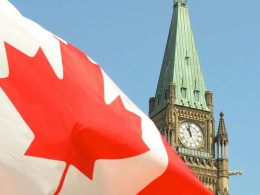For the second time in a row, the Bank of Canada has opted to stand pat, holding its overnight rate steady at 2.75%. It’s the same rate they landed on back in April, and according to RBC Senior Economist Claire Fan1, it reflects a central bank trying to stay cautious in a “softer but not sharply weaker” economic environment.
That 2.75% figure? It happens to sit right in the middle of the Bank’s estimated “neutral” range—between 2.25% and 3.25%—which makes this pause feel more like a balancing act than a bold move.
So what’s actually driving this latest decision, and where could things go from here? Fan digs into both in her latest economic update, zeroing in on the same two questions the BoC itself asked back in April. Spoiler: those questions are still doing a lot of heavy lifting in guiding rate expectations.
Inflation’s Still Sticky, and the Economy’s Still Softening—But Not Crumbling
As Fan puts it, what comes next for rates “will be largely determined by the extent of further softening in the economy.” Right now, both RBC and the Bank of Canada expect growth to take a hit in the second quarter, with unemployment ticking higher alongside it.
And to make sense of it all, Fan brings us back to two questions first raised by the BoC earlier this year.
1. How much damage is the trade war actually doing?
Fan says the data since April has been a bit of a mixed bag. “Q1 GDP was stronger than the BoC expected,” she notes—but that bump came in part from businesses pulling forward demand to get ahead of tariffs. That front-loading effect likely means weaker activity in Q2.
And while the job market has held up okay in some areas, cracks are showing. “The unemployment rate has risen as hiring scales back broadly while manufacturing sees significant job losses,” Fan writes.
The BoC was hoping for a relatively calm Q2, assuming tariff rates on Canadian exports to the U.S. would hover around 1%. That’s not happening. “We’re tracking around 4.5%,” Fan says, thanks to fresh hikes on U.S. tariffs for Canadian steel and aluminum.
Still, she points out that things could be worse. “Canada is still at the bottom of the ranking when it comes to the tariff rates that are attached to each U.S. trade partner,” she says.
Despite all this, early signs from Q2 haven’t been completely grim. Sure, housing is still under pressure, but Fan says “there are signs that the bleed in domestic consumption and labour market conditions could be contained.” She cites RBC credit card data showing a “solid increase in April spending,” plus early job posting numbers from Indeed that suggest even trade-exposed sectors like manufacturing and transportation might be bouncing back.
In other words, things could have been worse—and that might matter. “Better than feared economic data in Q2 could raise the odds of a closer terminal rate than the one we're expecting,” Fan warns. Translation? The BoC might be closer to the end of its rate-cutting cycle than most people think.
2. Is inflation still being pushed up by more than just tariffs?
Fan’s take? “It’s still too early to tell.”
Yes, April’s core CPI surprised to the upside. But instead of being driven by tariffs, Fan says it came mostly from domestic service prices. Even so, she’s cautious. “A flare-up at the onset of tariffs sets a bad starting point for inflation trends later this year.”
BoC Governor Tiff Macklem echoed that sentiment in his press conference. According to Fan, he emphasized how hard it is to separate the inflationary impact of tariffs from everything else. That’s why the Bank is leaning more on “soft data and intel from businesses that already suggested cost increases,” she reports.
Still, Fan isn’t ringing alarm bells just yet. “Generally targeted counter-tariff measures and other reasons outlined here underpin our expectation of noticeable but moderate impact to Canadian inflation from tariffs this year,” she writes.
In fact, there might be an offsetting factor at play. Fan notes that the inflation boost from tariffs could be roughly balanced out by “the end of consumer carbon tax,” which means headline CPI might still hover just above 2% through the second half of 2025.
And while inflation expectations are still anchored—which is a good sign—Fan flags one risk: “Faster rising/more heightened than expected price pressures could also raise odds of fewer rate cuts from the BoC.”
What to Watch Now? The Data, Not the Drama
Fan’s update leaves one thing clear: the BoC isn’t making any big promises, and for good reason. With trade tensions still bubbling, inflation acting unpredictably, and the broader economy sending mixed signals, the central bank is being careful.
If the economy stays firmer than feared and inflation proves stickier, we could be close to the peak—or the floor—of this rate cycle. But if things slow more sharply and inflation cools off, there’s still room for cuts.
Either way, Fan’s framing gives investors and policy watchers a useful lens: don’t just follow the Bank—follow the numbers. Because for now, standing still might be the Bank of Canada’s smartest move.
Footnote:
1 RBC Royal Bank Economics. “Another pause from the BoC" 4 June 2025
















